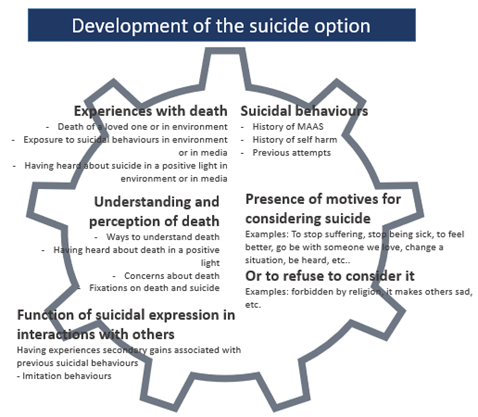This last step of the suicide prevention clinical process is crucial and must not be neglected. It is completed in the long term based on a functional analysis of the person, and of their risk and protective factors.
It is made by the clinical team usually intervening with the person.
 |
The Suicide Prevention Plan – Risk (SPP-R) aims to support the professional at this step. The document Reducing the Long-Term Suicide Risk also proposes several other useful tools, including illustrated social scenarios to explore recurrence of suicidal ideations, beliefs and myths about suicide, contagion and imitation phenomena, etc. |
Objectives of suicide risk reduction
The Suicide Prevention Plan – Risk (SPP-R) aims to identify more distal risk factors and complete the information collected during the suicidal episode management, in order to:
- Understand the person’s suicidal process
- Make decisions concerning the danger of a future suicidal episode (long-term suicide risk)
- Define interventions to reduce risk factors, reinforce protective factors and modify the suicidal process.
Observe: Risk assessment indicators
The following elements can be observed in order to assess suicide risk and determine possible long-term interventions:
- Presence of risk and protective factors (at the levels of the individual, the family, the environment, etc.)
- Exploration of the suicide option (see Understanding Suicide Risk)
- Understanding patterns and functions of suicide-related manifestations (MAAS)
- Assess the risk of MAAS recurrence and becoming chronic
The Table below describes information to collect to reduce long-term suicide risk. A more detailed version of this Table is available in the document Reducing Long-Term Suicide Risk.
| Information to collect | Description and examples |
| Predisposing Factors | Cognitive rigidity, poor adaptation capacity, general anxious affect, unstable mood, attachment issues, history of substance abuse, mental health disorders, type and level of ID or ASD, associated disorders (ADHD, Behavioural disorders, etc. |
| Contributing Factors | Feeling of being limited/dependant, perception of self as being abnormal, misconception of diagnosis, poor self-esteem, substance abuse, impulsivity. Inadequate activity structure, issues with mental health follow-ups, difficult relationships with loved ones, isolation/rejection, inadequate social integration, difficulties with life goals, environment that limit opportunities for self-determination. |
| Activating Factors and Trigger Events | Aggravation of mental health disorders, current substance use, any element that can act as the last straw (trigger). Any element that can act as the last straw (trigger) that acts from the outside: Bad news, loss, etc. |
| Protective Factors | Ability to self-calm quickly, ability to identify solutions and to adapt, feeling of having control on their life, presence of reasons for living. Ability to express emotions and needs. Balance between environmental demands and the person’s capacities, adapted social integration, presence of people providing security, presence of sources of satisfaction, knowledge and acceptance of diagnosis by social environment, presence of trust relationship. |
| Exploration of the suicide option |  |
| Critical moments in all MAAS episodes experienced by the person and consequences | Difficult periods lived between follow-ups and possible predictable trigger events that require the implementation of a safety net. The identification of trigger events is made by observing the person’s reactions in their environment and by consulting their loved ones and associated professionals. Fill in only if multiple suicidal episodes |
| Presence of previous MAAS and summary of different episodes experienced by person | Analysis based on the behavioural functional assessment, by describing MAAS patterns, if one emerges from the observation of multiple MAAS episodes. Types of triggers: Type of MAAS and escalation structure (precursory behaviours, words used, behaviours, means, rituals, etc.). Immediate consequences (including the behaviours of loved ones, peers, professionals, emergency responses, medical consultations, changes in expectations or routines, etc.). Fill in only if multiple suicidal episodes. |
| Understand the function of MAAS by examining one or more episodes of MAAS (multimodal assessment plan) | Hypotheses as to the relationship between triggers, risk and protective factors, MAAS and consequences (including possible hypotheses on secondary benefits, if applicable). Each hypothesis must be supported by arguments identified in previous steps. |
Decide: Assess the long-term suicide risk
The decision on suicide risk factors and other elements in the Suicide Prevention Plan – Risk can be made based on the following questions:
- Does the person present risk factors on which it is important to act to reduce distress and the risk of MAAS recurrence?
- Does the person present elements associated to the suicide option?
- Does the person present MAAS patterns on which to base interventions?
Act: Interventions to reduce suicide risk
The implemented long-term interventions do not target the MAAS directly, but the associated factors instead. Their implementation does not require discussing the suicidal episode with the person.
Act upon risk and protective factors
- Reduce impact of trigger events
- Increase protective factors
- Decrease risk factors
- Increase social skills and ability to express emotions and needs
- Adapt environmental structures
- Treat health issues (physical and mental)
- Work on self-esteem
Reduce the suicide option
- Reduce fixations
- Psychoeducation on death and suicide
- Work on positive perceptions or on misconceptions on death and suicide
- Understand and reduce secondary benefits (within interactions with others) of MAAS
- Reduce the use of MAAS in interactions with others
- Reframing in relation to suicide, suffering, help seeking and solutions
- Understanding the impact of MAAS on the entourage (consequences)
Target the patterns of suicide-related manifestations (MAAS)
- Reduce the risk of recurrence
- Deconstruct the patterns and functions of MAAS
 |
The document Reducing the Long-Term Suicide Risk presents several useful tools, including illustrated social scenarios to explore recurrence of suicidal behaviors, beliefs and myths about suicide, the imitation or contagion phenomena, etc. The proposed tools are specifically tailored for persons with ID and/or ASD. |

Creative Commons Attribution-NonCommercial-ShareAlike 4.0 International Public License
